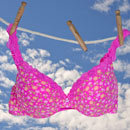5 Incredible NASA Technologies (With Goofy Secondary Uses)

NASA is responsible for some of the most amazing technological miracles of the past century (that whole "putting a man on the moon" thing was craaaaazy). As consumers, it is our duty to take those amazing achievements and repurpose them in totally asinine and self-serving ways.
Cancer-Destroying Balloons That Fix Your Hair

NASA's Dennis Morrison created nanoceramics -- tiny ceramic balloons 10,000 times thinner than a human hair that can be filled with cancer medication and injected directly into malignant tumors. This is sort of like the plot to Armageddon, only instead of detonating an asteroid from the inside out, NASA is annihilating the swollen cancer baseball on Grandma's eyebrow.
Also Used For:
Frizz control. The nanoceramics release ions that smooth and relax hair, so a hairstyling company called Farouk Systems incorporated the technology into a line of flat irons, making the world a better place for Jared Leto.
Memory Foam That Remembers to Make Boobs Look Awesome

NASA has been using memory foam since the 1970s to protect astronauts during takeoffs and landings (although its application in scattered upper-atmosphere detonations is still being determined).
It can also be used to make prosthetic limbs. Memory foam can match the look, feel and color of a non-ripped-off arm, while simultaneously creating a cushioning seal between the prosthetic and the recipient that won't chafe the skin or terrify children the way plastic nightmare hook limbs do.
Also Used For:
Boob enhancement. Memory foam swells in response to heat, and already kind of feels like a 13-year-old boy's concept of breasts, so it's being used in "memory bras" that push a woman's chesticles up and out when she's feeling all hot and bothered, helpfully letting everyone in the room know exactly what time it is.
Sound-Wave-Treated Sea Kelp Salve That Robs Old Women (So to Speak)

Max Huber, a NASA scientist in the 1960s, suffered severe rocket fuel burns after a laboratory accident (presumably involving Wile E. Coyote). To treat his horrible melted jigsaw face, he developed a salve from sound-wave-fermented sea kelp (seriously) and petroleum.
Also Used For:
Wrinkle softening. After Huber's death, Estee Lauder bought the formula from his daughter and turned it into Creme de la Mer, an anti-aging cream they sell for $130 a jar to deflated old women.
Protective Glass That Makes Beautiful Jewelry

By depositing layers of metal films onto glass, NASA scientists made what they call dichroic glass, which filters out UV rays. You see, unfiltered sunlight in space can burn your eyes out of your head and/or destroy sensitive equipment, so they required something more substantial than the pair of Ray-Bans Corey Feldman wears in License to Drive.
Also Used For:
Jewelry. Dichroic glass is super pretty, so it gets used in earrings and necklaces, and is even incorporated into stained glass. One of the developing scientists quit his job at NASA (quit his job at NASA) to start making dichroic glass art full time, because Space Science University evidently doesn't teach you how money works.
Missile Defense That Will Fix Your Crooked Teeth

To protect the sensitive transmitters on heat-seeking-missile trackers, NASA developed a material called translucent polycrystalline alumina (TPA), which is more durable than glass and allows the infrared signals to pass through more easily. It is unclear why NASA spent so much time on missile defense, unless they are anticipating a barrage of photon torpedoes from an orbiting space lobster mother ship.
Also Used For:
Invisible braces. TPA's transparency and toughness make it the ideal material to reshape the snaggle-toothed trapjaws of the rich and vain without bruising their egos. So, instead of looking like you have braces, you can now look like you just have a bunch of vague shit on your teeth.
Cassandra Sue is a full-time travel editor who rarely goes anywhere at all. She has a cool blog about being an American in Amsterdam, but lately she's just an American in America, so here's her Twitter. If you pay her, she'll write for you, so send her email (amsterdamyankee@gmail.com).